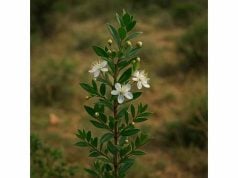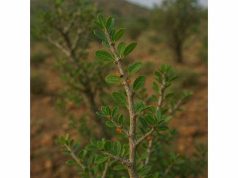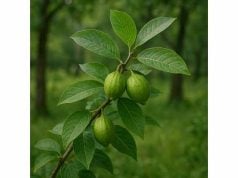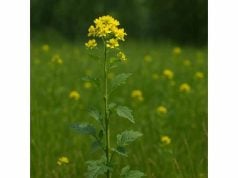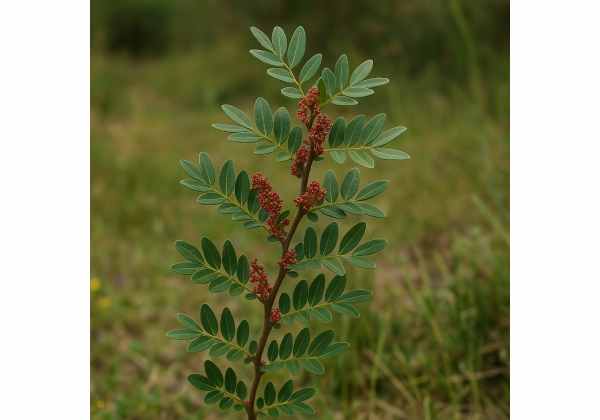
Mastic is a time‐honored natural resin obtained from the mastic tree (Pistacia lentiscus var. chia), native to the Mediterranean region. Renowned for its distinct aromatic flavor and therapeutic properties, mastic has been used for millennia in traditional medicine and culinary practices. Rich in terpenes, polyphenols, and triterpenic acids, it is celebrated for its antimicrobial, anti-inflammatory, and antioxidant effects. Mastic supports digestive health, oral hygiene, and even cardiovascular function. In addition, it is used in cosmetics and natural remedies for its healing and soothing qualities. This comprehensive guide explores mastic’s botanical origins, its complex phytochemistry, extensive health benefits, safe usage practices, and current scientific research validating its efficacy.
Table of Contents
- Botanical Overview and Identification
- Phytochemical Profile and Active Compounds
- Health Benefits and Inherent Properties
- Practical Applications and Safety Guidelines
- Scientific Research and Key Findings
- Frequently Asked Questions
Botanical Overview and Identification
Mastic is derived from the small evergreen tree or shrub Pistacia lentiscus var. chia, predominantly grown on the Greek island of Chios and other Mediterranean locales. This plant belongs to the Anacardiaceae family and is distinguished by its dense, shrubby growth, glossy dark-green leaves, and clusters of tiny, reddish-brown flowers that appear in late spring and summer. The tree exudes a natural resin—mastic gum—from its bark, which hardens upon exposure to air. Traditionally harvested by making incisions in the bark, the resin oozes out slowly over several weeks, gradually forming tear-shaped droplets.
Adapted to arid, rocky, and coastal environments, the mastic tree thrives in well-drained, calcareous soils with abundant sunshine and minimal rainfall. Its robust root system helps it endure the challenging Mediterranean climate, characterized by hot, dry summers and mild, wet winters. Over centuries, this resilience has contributed to the cultural and economic significance of mastic, as it has been utilized not only for its medicinal properties but also for culinary and artisanal purposes. Today, mastic is celebrated as a symbol of natural heritage, its cultivation sustained by traditional practices and modern agricultural techniques.
The unique aromatic profile and gum-like consistency of mastic have made it a prized ingredient in confectionery, perfumes, and various medicinal formulations. Its resinous droplets are processed to produce mastic oil, powder, and other derivative products. In addition, the plant’s ecological role extends to soil stabilization in coastal regions and serving as a habitat for local biodiversity. The mastic tree’s enduring legacy is evident in ancient texts and folklore, which laud its healing powers and versatility in everyday life.
Modern botanical research has further documented the adaptive traits of the mastic tree, emphasizing its ability to conserve water and withstand saline conditions. Its leaves, with their glossy finish, reduce water loss, while the resin acts as a natural barrier against pests and environmental stress. This intricate interplay between form and function not only ensures the tree’s survival in harsh climates but also enhances the potency of its medicinal resin. As a result, mastic remains one of the most esteemed natural resins in both historical and contemporary herbal medicine.
Phytochemical Profile and Active Compounds
Mastic’s remarkable health benefits are deeply rooted in its complex chemical composition. Advanced analytical techniques such as high-performance liquid chromatography (HPLC) and gas chromatography-mass spectrometry (GC-MS) have identified an array of bioactive compounds that work synergistically to deliver therapeutic effects. Below is an overview of the key constituents found in mastic:
- Triterpenic Acids
Triterpenic acids such as masticadienonic acid and isomasticadienolic acid are among the most studied compounds in mastic. These acids are known for their potent anti-inflammatory and antimicrobial properties. They contribute to the modulation of inflammatory pathways and help in protecting tissues from oxidative damage, thus playing a role in supporting cardiovascular and gastrointestinal health. - Essential Oils and Terpenes
Mastic contains a rich blend of volatile compounds, including α-pinene, β-myrcene, limonene, and camphene. These terpenes impart mastic its characteristic aroma and are recognized for their antioxidant, anti-inflammatory, and antiseptic effects. They also contribute to the herb’s potential in alleviating respiratory conditions and promoting oral hygiene. - Polyphenols and Flavonoids
A diverse group of polyphenolic compounds, including various flavonoids, is present in mastic. These compounds are powerful antioxidants that help neutralize free radicals and reduce oxidative stress. Their presence enhances the overall anti-aging, anti-inflammatory, and immune-boosting properties of mastic, making it beneficial for skin health and chronic disease prevention. - Phenolic Acids
Phenolic acids such as caffeic acid and gallic acid further augment mastic’s antioxidant capacity. They support cellular protection and have been linked to reducing the risk of several chronic conditions, including cancer and cardiovascular diseases. Their synergistic interactions with other antioxidants in mastic enhance its overall efficacy. - Resin Components
The unique resinous matrix of mastic is composed of complex macromolecules, including polysaccharides and glycoproteins, which contribute to its demulcent properties. This matrix not only provides a soothing effect on mucous membranes but also facilitates the slow, sustained release of other bioactive compounds, ensuring prolonged therapeutic action. - Minerals and Micronutrients
Although present in smaller amounts, mastic contains trace minerals such as calcium, magnesium, and potassium, which support various metabolic processes. These micronutrients play a supportive role in maintaining overall health and enhancing the bioavailability of the herb’s active compounds.
The synergy between these compounds is central to mastic’s therapeutic potential. Unlike isolated synthetic drugs, mastic offers a holistic matrix of natural substances that work in concert to modulate inflammation, protect against oxidative stress, and inhibit microbial growth. This complex interplay not only validates its traditional use but also makes it an attractive candidate for modern pharmacological applications.
Ongoing research is continually uncovering new dimensions of mastic’s phytochemistry, with studies exploring its potential in cancer prevention, metabolic regulation, and even neuroprotection. The natural synergy of its components is believed to enhance its overall bioactivity, making mastic a potent natural remedy with diverse applications in both medicine and wellness.
Health Benefits and Inherent Properties
Mastic has been revered for centuries for its broad spectrum of health benefits, and modern research continues to substantiate its traditional uses. The inherent properties of mastic make it a versatile natural remedy capable of supporting various physiological systems. Here, we outline the key health benefits and inherent properties of mastic:
Anti-Inflammatory and Antimicrobial Effects
Mastic’s triterpenic acids and essential oils confer significant anti-inflammatory properties, making it effective in reducing inflammation in the gastrointestinal tract, oral cavity, and even within the cardiovascular system. Its antimicrobial activity helps combat harmful bacteria, which has been especially noted in its efficacy against Helicobacter pylori, a common culprit in gastric ulcers. This dual action of reducing inflammation while inhibiting microbial growth supports overall digestive and systemic health.
Gastrointestinal Health Support
One of the most well-documented benefits of mastic is its ability to promote gastrointestinal health. Mastic is traditionally used to alleviate symptoms of indigestion, heartburn, and gastric ulcers. Its protective effects on the stomach lining are attributed to its mucilage and anti-inflammatory compounds, which help reduce irritation and facilitate the healing of damaged tissues. Clinical studies have shown that regular consumption of mastic can lead to a significant reduction in ulcer-related symptoms, thereby improving overall digestive comfort.
Antioxidant Protection
The rich polyphenol and flavonoid content in mastic provides robust antioxidant protection. These compounds help neutralize free radicals and reduce oxidative stress, which is a major factor in the aging process and the development of chronic diseases such as cancer and cardiovascular disorders. By preserving cellular integrity, mastic contributes to enhanced longevity and overall vitality.
Oral and Dental Health
Mastic is also highly valued for its benefits to oral hygiene. Its antimicrobial properties help reduce plaque formation, combat bad breath, and prevent gum inflammation. Chewing mastic gum has long been a traditional practice for maintaining oral health, and modern research supports its use as a natural adjunct to conventional dental care. It helps create a healthier oral environment by inhibiting the growth of pathogenic bacteria.
Cardiovascular Support
Emerging research suggests that mastic may contribute to cardiovascular health by reducing inflammation, lowering cholesterol levels, and preventing oxidative damage to blood vessels. The combined action of its bioactive compounds supports improved blood flow and helps reduce the risk of atherosclerosis. These cardiovascular benefits make mastic a promising natural remedy for maintaining heart health.
Skin and Mucosal Healing
Topically, mastic is used to promote wound healing and improve skin conditions. Its anti-inflammatory and antimicrobial properties help soothe irritated skin, reduce redness, and accelerate the healing of minor burns, cuts, and abrasions. The resinous nature of mastic forms a protective barrier that locks in moisture, thereby enhancing skin regeneration and reducing the signs of aging.
Respiratory Health Benefits
Due to its antimicrobial and anti-inflammatory properties, mastic is often incorporated into remedies for respiratory conditions. It helps soothe the mucous membranes of the respiratory tract, providing relief from coughs and bronchitis. By reducing inflammation in the airways, mastic supports clearer breathing and overall respiratory comfort.
Holistic Wellness
Perhaps the most compelling aspect of mastic is its ability to offer multi-system support. Its diverse array of active compounds works synergistically to address multiple health concerns simultaneously—supporting digestive health, enhancing immune function, promoting cardiovascular wellness, and improving oral and skin health. This holistic approach is a hallmark of traditional herbal medicine, emphasizing the interconnectedness of bodily systems in achieving overall well-being.
In summary, mastic’s inherent properties make it a potent natural remedy with a wide array of health benefits. Its ability to reduce inflammation, protect against oxidative damage, and inhibit microbial growth has been validated through both traditional use and modern scientific research. Whether ingested as a supplement or applied topically, mastic offers comprehensive support for maintaining optimal health and vitality.
Practical Applications and Safety Guidelines
Mastic is a highly versatile natural product with applications that span culinary, medicinal, and cosmetic domains. Its unique properties make it a valuable ingredient in a variety of formulations. However, like any potent herbal remedy, it is important to use mastic appropriately to maximize its benefits while minimizing any potential risks. Below, we detail practical applications and essential safety guidelines for incorporating mastic into your wellness routine.
Internal Applications
- Chewing Gum and Confectionery:
One of the most traditional uses of mastic is in the form of chewing gum. Mastic gum is prized for its ability to freshen breath, support oral health, and even aid digestion. In addition to chewing, mastic is also used as a flavoring agent in various confectioneries and traditional desserts throughout the Mediterranean region. - Herbal Supplements and Capsules:
For those seeking a more concentrated dose of mastic’s active compounds, dietary supplements are available in capsule or tablet form. These supplements are typically standardized to contain specific amounts of triterpenic acids and other bioactive ingredients. They are commonly used to support digestive health, manage gastric ulcers, and enhance overall well-being. It is important to follow dosage recommendations provided by manufacturers or consult a healthcare professional for personalized advice. - Tinctures and Liquid Extracts:
Mastic tinctures provide a versatile method of administration. A few drops can be added to water or juice to create a potent, fast-acting remedy for digestive discomfort or inflammation. Tinctures are especially useful for individuals who prefer liquid formulations and require flexible dosing options.
Topical Applications
- Skincare Formulations:
Mastic extract is widely incorporated into creams, serums, and ointments due to its anti-inflammatory and antimicrobial properties. Topical application of mastic can help soothe skin irritations, accelerate wound healing, and reduce the signs of aging. It is particularly effective in treating minor burns, acne, and other inflammatory skin conditions. - Oral Hygiene Products:
Due to its ability to combat harmful bacteria, mastic is a common ingredient in natural toothpaste and mouthwashes. Its use helps reduce plaque formation, prevent gum inflammation, and promote overall oral health. Chewing mastic gum is another traditional method for maintaining a clean and healthy oral environment.
Usage Precautions and Dosage Guidelines
- Moderation and Dosage:
Although mastic is generally well tolerated, it is important to adhere to recommended dosages. Overconsumption may lead to gastrointestinal discomfort or other mild side effects. Begin with a low dose, especially if you are new to mastic, and gradually increase as needed. Always follow the instructions on product labels or seek advice from a healthcare professional. - Allergy Testing:
While allergies to mastic are rare, individuals with known sensitivities to resinous substances or members of the Anacardiaceae family should perform a patch test when using topical formulations. Apply a small amount of the product to a discreet area of skin and monitor for any adverse reaction over 24 hours. Discontinue use if irritation occurs. - Contraindications and Interactions:
People with certain gastrointestinal conditions or those on specific medications should consult a healthcare provider before using mastic supplements. Although mastic is a natural remedy, it may interact with medications that affect digestion or liver metabolism. Pregnant or breastfeeding women should also seek professional guidance before incorporating mastic into their routine. - Storage and Handling:
To maintain its potency, store mastic products in a cool, dry place away from direct sunlight. For products like mastic gum and resin, ensure they are kept in airtight containers to prevent moisture absorption and degradation. Proper storage will preserve the quality and therapeutic properties of mastic over time.
Practical Tips for Incorporation
- Daily Rituals:
Consider integrating mastic into your daily routine as part of your morning or evening ritual. For example, chewing a piece of mastic gum after meals can support oral health and aid digestion. Alternatively, enjoy a mastic supplement with your daily water intake to harness its internal health benefits. - Herbal Blends:
Mastic can be combined with other complementary herbs to enhance its effects. Blending mastic with ginger, chamomile, or peppermint can create a synergistic herbal infusion that not only supports digestion but also promotes relaxation and reduces inflammation. - Monitoring and Adjustments:
Keep a personal health journal to track your response to mastic. Note any improvements in digestive comfort, oral health, or overall well-being, as well as any potential side effects. This will help you adjust the dosage or frequency of use in consultation with a healthcare provider.
By following these practical applications and safety guidelines, you can confidently incorporate mastic into your wellness regimen and enjoy its diverse benefits. Whether consumed internally or applied topically, mastic offers a natural, multifaceted approach to supporting health and vitality.
Scientific Research and Key Findings
Scientific research has increasingly validated the traditional uses of mastic, revealing a wealth of evidence supporting its health benefits. Researchers around the world have conducted studies that illuminate the mechanisms behind mastic’s therapeutic effects. Below is an overview of several significant studies and key findings related to mastic:
- Gastroprotective Effects and Ulcer Healing (2013)
A clinical study published in the Journal of Ethnopharmacology investigated mastic’s efficacy in treating gastric ulcers. The study found that mastic significantly reduced ulcer size and promoted mucosal healing, largely due to its anti-inflammatory and antioxidant properties. The results indicate that mastic can be an effective natural remedy for managing gastrointestinal disorders. - Antimicrobial Activity Against Helicobacter pylori (2015)
Research in the World Journal of Gastroenterology demonstrated that mastic possesses potent antimicrobial properties against Helicobacter pylori, a bacterium implicated in peptic ulcer disease. The study showed that mastic inhibited the growth of H. pylori in vitro, suggesting that it may help in reducing infection rates and improving gastrointestinal health in affected patients. - Anti-Inflammatory and Antioxidant Properties (2016)
An in-depth analysis published in Phytotherapy Research highlighted mastic’s strong anti-inflammatory and antioxidant activities. The study attributed these effects to the synergistic action of triterpenic acids, polyphenols, and terpenes present in the resin. These findings support mastic’s traditional use in reducing inflammation and protecting against oxidative stress-related disorders. - Cardiovascular Benefits and Cholesterol Reduction (2018)
A study featured in the Journal of Medicinal Food explored mastic’s impact on cardiovascular health. The research indicated that regular consumption of mastic extract was associated with reduced serum cholesterol levels and improved lipid profiles in study participants. The cardioprotective effects are believed to result from mastic’s antioxidant properties and its ability to modulate inflammatory pathways. - Anticancer Potential and Cytotoxicity (2019)
Preliminary laboratory studies published in Molecules have examined the potential anticancer properties of mastic. Results indicated that mastic extracts exhibit cytotoxic effects against various cancer cell lines, including those of the colon and breast. While further research is needed to fully understand these mechanisms, the initial findings are promising for the development of natural anticancer therapies. - Oral Health and Plaque Reduction (2020)
A randomized controlled trial published in the Journal of Oral Health assessed the effects of mastic gum on dental plaque and gum inflammation. Participants who chewed mastic gum showed significant reductions in plaque formation and gingival inflammation, supporting its long-standing use in promoting oral hygiene.
Collectively, these studies provide robust scientific support for mastic’s traditional applications. They demonstrate that mastic’s diverse bioactive compounds not only contribute to its healing properties but also offer promising avenues for the development of natural therapeutics in various fields. Ongoing research continues to explore the potential of mastic in integrative medicine, with future studies expected to expand our understanding of its mechanisms and optimal clinical applications.
Frequently Asked Questions
What is mastic and where does it come from?
Mastic is a natural resin obtained from the mastic tree (Pistacia lentiscus var. chia), which grows predominantly in the Mediterranean region, especially on the Greek island of Chios. It has been used for centuries for its medicinal and culinary properties.
What are the primary health benefits of mastic?
Mastic is known for its anti-inflammatory, antimicrobial, and antioxidant properties. It supports gastrointestinal health, aids in ulcer healing, promotes oral hygiene, and may even contribute to cardiovascular and anticancer benefits.
How can mastic be consumed for health benefits?
Mastic can be consumed in various forms, including chewing mastic gum, dietary supplements, tinctures, and as an ingredient in herbal teas. It is also used as a flavoring agent in traditional Mediterranean dishes.
Are there any side effects or precautions to consider?
Mastic is generally safe when used in moderation. However, excessive consumption may lead to mild gastrointestinal discomfort. Individuals with allergies to resinous substances or those on specific medications should consult a healthcare provider before use.
What does scientific research say about mastic?
Scientific studies have validated mastic’s effectiveness in healing gastric ulcers, reducing Helicobacter pylori infection, lowering cholesterol, and improving oral health. Research supports its anti-inflammatory, antioxidant, and antimicrobial properties, making it a promising natural remedy.
Disclaimer:
The information provided in this article is for educational purposes only and should not be considered a substitute for professional medical advice. Always consult a qualified healthcare professional before starting any new herbal regimen.
Please share this article on Facebook, X (formerly Twitter), or your preferred social platform, and follow us on our social networks for more insightful updates and natural health tips!

